Small House Bugs With Pictures and Names – Identification Guide
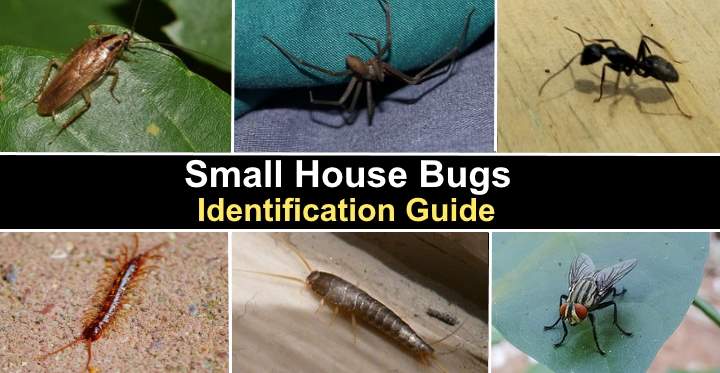
Finding small bugs crawling or flying around your house can be a frightening experience. However, noticing a small black bug could be nothing to worry about. Many types of house spiders, beetles, or fruit flies are relatively harmless. However, small brown bugs like cockroaches, ants, or bed bugs scurrying along a baseboard or lurking in crevices could be a sign of a more extensive bug infestation. Identifying common house bugs is the first step in knowing how to get rid of them.
No one wants any kind of bugs in their house. Some black or brown house bugs like fleas, roaches, or bed bugs can jump, bite, or carry diseases. Other types of bugs common in homes, like some spiders or bed bugs, can cause a nasty painful bite or irritating skin reaction if they sting you. If you notice houseflies around fruit or on meat, you could suddenly lose your appetite.
Many people refer to any type of creeping household pest as a bug. However, not all annoying crawling or flying insects are true bugs (order Hemiptera). For example, beetles are a type of insect in the order Coleoptera. Roaches are brown insects in the order Blattodea. This article will refer to all types of insect pests as bugs—regardless of whether they are true bugs or not.
This article is a guide to identifying common types of house bugs that can infest indoor areas. Descriptions and pictures of the beetles, roaches, spiders, fleas, flies, and ticks will help to identify what nasty creatures could be lurking in your home.
How to Identify House Bugs
To accurately identify bugs in your house, it’s vital to look at the insect’s size, shape, number of legs, and if it has wings. For example, spiders, mites, and ticks have eight legs and no antennae. In addition, mites and ticks are so tiny that they may look like black dots.
All insects have six legs and at least two antennae. To identify a cockroach or a beetle, you should look at the shape of the body. Beetles are smaller insects with a harder body and are usually black “bugs.” On the other hand, roaches are brown bugs with long, slender antennae.
Types of Small House Bugs with Pictures – Identification
After noticing a critter scurrying across the floor or discovering a collection of tiny black bugs behind a bed, you probably want to know what kind of bug you’re dealing with. Please read on to find out how to identify types of small house bugs.
Cockroaches (Blattodea)

Common roach (German roach/Blattella germanica) on the left and American roach (Periplaneta americana) on the right
Cockroaches are small reddish-brown house bugs with slender oval bodies, six legs, and long antennae. Common roaches (Blattella germanica) in the home are 0.6” (15 mm) long. However, the largest roaches (Periplaneta americana) have wings and grow up to 3” (75 mm) long. Cockroaches are common small house bugs that usually lurk in dark crevices, cupboards, and behind furniture.
You can usually spot a cockroach after turning on a light or opening a cupboard door. The fast-moving brown insects scurry away from the light.
Cockroaches can enter homes through ventilation units, along pipes, when bringing home used items, or hitching a ride in shopping bags. Usually, the oval brown bugs prefer dark, warm, damp places. Nevertheless, it’s crucial to get rid of roaches because they can spread disease and contaminate food or utensils.
Some beetles, crickets, and water bugs look like cockroaches and are easy to confuse for these disease-carrying brown bugs.
House bug Identification: Cockroach identification is by their flattened, elongated oval brown or black bodies, long slender antennae, and love of dark places. Signs of a roach infestation are pepper-like fecal droppings and a musty odor.
Carpet Beetles (Anthrenus verbasci)
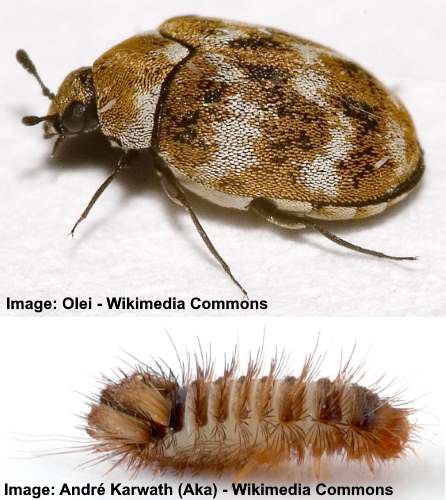
Carpet beetle (top image) and larva (bottom image)
Carpet beetles are tiny oval house bugs with an irregular pattern of brown, yellowish and white patches, short antennae and measure between 0.7” and 0.14” (1.7 – 3.5 mm). The rounded, flattened, dark-colored insects have wings and can fly into the home. The carpet beetle lives for four to eight weeks and can lay up to 90 eggs.
Carpet beetles are generally harmless house bugs. But it’s their larvae that are real pests. The brown fuzzy beetle larvae feed on fibers like wool, cotton, leather, and silk. The brown insect larvae chew holes in soft furnishings like clothing, rugs, and carpets.
House bug Identification: To identify carpet beetles in your house, look for tiny dark bugs with yellowish and white patches flying near lights or crawling on surfaces. The most common way of identifying carpet beetles is by looking for chewed holes in fabric and the brown shed skin of carpet beetle larvae.
Spiders (Araneae)
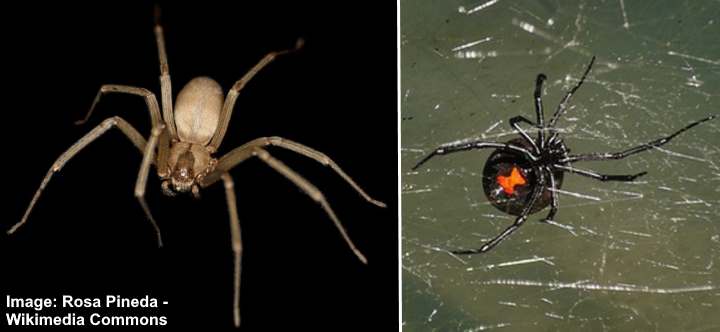
Left picture: brown recluse spider. Right picture: Black widow spider
Spiders are common household pests that come in all shapes and sizes. Typically, spiders are easy to spot due to their eight spindly legs, rounded body, and lack of antennae. Brown or black house spiders can be furry or have smooth bodies and measure up to 0.8” (20 mm) long.
Identifying spiders in the home is vital as some can be dangerous. Two types of harmful spiders are the brown recluse and the black widow. The violin-shaped markings identify the brown recluse on the front part of its body. Black widows are identified by distinctive red markings on a black, shiny body.
However, most spiders in the house are not considered pesky bugs. Common house spiders can be beneficial as they prey on flies that can infest your plants.
House bug Identification: Spiders are identified by their eight legs, the type of web they create, and markings on their bodies.
Houseflies (Musca domestica)

Houseflies (Musca domestica) are common house bugs that can cause infestation in large quantities
Houseflies are common flying black house bugs with a dark gray body, transparent wings, six legs, two large compound eyes, and measure 0.15” to 0.29” (4 – 7.5 mm) long. Although they don’t bite, the grayish-black flies spread disease by feeding on garbage, rotten food, and feces.
If you see these small black flies in your home, you should kill them to prevent them from spreading bacteria. To get rid of houseflies, identify areas where the small black bugs lay their eggs. This could be a trash can, uncovered pet food, or something else rotten. Then you must eliminate the flies and their eggs to prevent them from infesting your house.
House bug Identification: Houseflies are identified by their small dark gray body, large pair of eyes, and tendency to fly erratically and buzz around light sources or windows.
Related articles: How to Get Rid of Maggots in the House and in Trash Can.
Weevils (Curculionoidea)
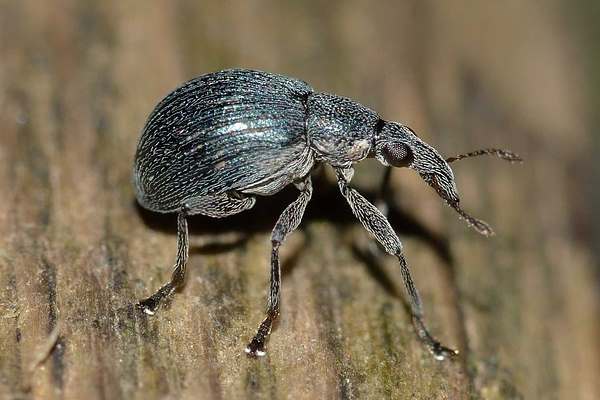
Weevils are small black beetles that can easily infest foodstuffs in your house
Weevils are slender black house bugs that easily infest unsealed foodstuffs in your pantry. Weevils are tiny black beetles with a distinctive long snout and a pear-shaped body. The small black house bugs measure up to 0.23” (6 mm) long. Black weevils don’t bite, but they can contaminate food with their droppings.
You can usually find the long black bugs crawling on walls and along window sills. You can generally use a vacuum cleaner to remove the pesky bugs. However, suppose you notice several slender black beetles in your home. In that case, it’s vital to thoroughly clean your kitchen and check all unsealed food items for black bugs.
House bug Identification: Weevils are identified by their shiny black oval body, long snout, and long black antennae.
Junk Bugs (Chrysopidae)
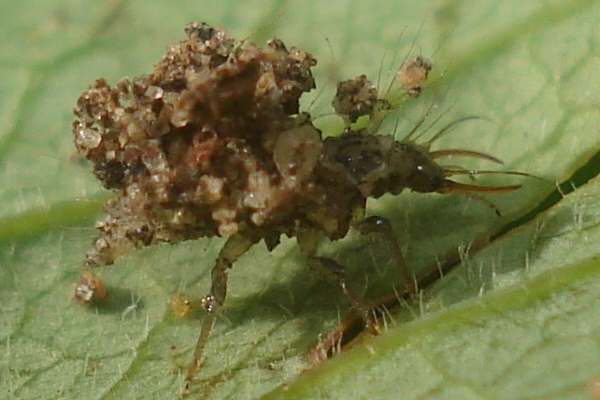
Junk bugs have unusual and ugly look as they use debris as camouflage
Junk bugs are weird brown bugs with triangular bodies, yellow markings, and brown heads. Junk bugs are the larval stage of green lacewings. The brown bug-like larvae have horn-like mouth-parts that they use to kill prey. However, their sharp jaws can also inflict a nasty bite, cause skin redness and swelling.
Junk bugs can be hard to spot because they have an interesting way of camouflage. The ugly brown bugs keep their killed prey and debris on their backs so that predatory ants and birds don’t notice them.
Green lacewings are beneficial insects that can help to control the numbers of common garden pests.
House bug Identification: Junk bugs are identified by their brown bodies, six legs, and tufts of yellowish spines along the sides of their abdomen.
Centipedes
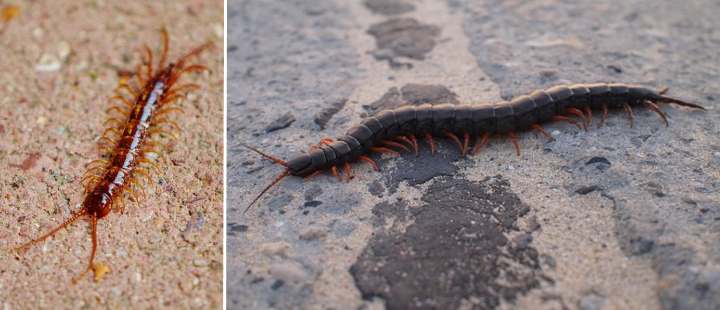
Centipedes are long creepy house bugs that are identified by numerous pairs of legs
Centipedes are long slender house bugs with multiple pairs of legs, two long antennae, and a pair of tails. Centipedes are venomous but usually don’t bite. If they do bite, their bite can vary in the level of pain from barely noticeable to very painful.
Centipedes range in size from a few millimeters up to 12” (30 cm) long. You can usually find centipedes in dark, secluded areas, and they typically come out at night.
Centipedes are common in homes with moisture problems. You may find them under sinks, in bathrooms, or damp basements. However, these long, multi-legged bugs rarely infest a home but are more of a nuisance.
Ways of getting rid of centipedes from a house include killing the bugs and then preventing them from getting inside the home.
House bug Identification: Centipedes are easy to identify due to the numerous pairs of legs along their long slender bodies. Some centipedes can have between 55 and 117 pairs of legs.
Stink bugs (Halyomorpha halys)
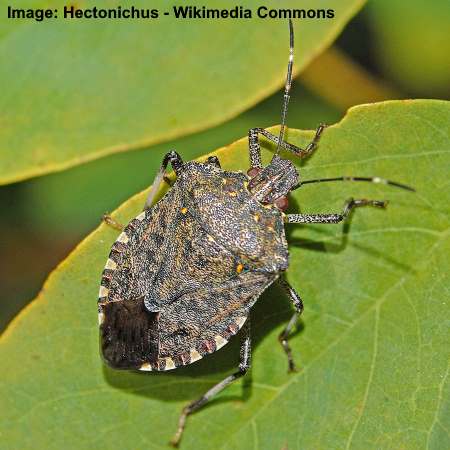
Stink bugs are flat home insects that emit a foul odor when crushed
Stink bugs are brown bugs with a flat body in the shape of a shield. Stink bugs have a mottled brown body, two straight antennae, and dark bands on their front wings. The small brown bugs measure 0.6” (1.7 cm) long and wide. They also emit a characteristic offensive odor, especially when squashed.
These shield-shaped brown bugs are relatively harmless to humans. The bugs enter houses through open windows or doors in the fall and overwinter in attics or crawl spaces. The stinky bugs become more active in spring when their rancid stench becomes more pronounced.
House bug Identification: Stink bugs have a distinctive brown body with marble-like patterning, six legs, and two dark antennae with white markings. On their recognizable shield-shaped body, they have black bands along the edge of their abdomen.
Beetles

Beetles are flying bugs that can infest homes and cause damage to wood or fabric
Beetles are small bugs that come in all shapes and sizes. All beetles are identified by their shell-like front wings, six legs, and rounded head. Some beetles can be black, and small black beetles may look like fleas. Other beetles can be colorful with green iridescent colors.
Although beetles are beneficial insects for controlling houseplant pests, they can cause damage in the house. Some types of beetles can chew through fabric or wood or contaminate food products. However, other beetle species like the ladybug are ideal for feeding on harmful garden pests such as aphids.
House bug Identification: There are over 400,000 species of beetles, so it’s difficult to identify each one. Like all insects, these flying bugs have six legs and two antennae.
Silverfish (Lepisma saccharina)

Silverfish is a creepy bug commonly found in damp places at home
Silverfish is a wingless grey-silvery bug with long antennae that slithers around the house floors in damp places. The name “silverfish” is an accurate description of this pest. The insect has a silvery appearance and fish-like movements as it quickly scurries over the floor. Silverfish measure between 0.5” and 1” (12 – 25 mm) long.
Silverfish is a common bug in bathrooms, damp attics, and showers. If excessive moisture is an issue, you will usually find the slithering silvery bug under bathtubs, sinks, and kitchen units. Usually, reducing humidity, fixing leaks, laying out sticky traps are ways to get rid of the pesky silver bugs.
House bug Identification: Silverfish have a slender silver body that tapers at the tail end. It’s easy to spot the silverfish with its fish-like motion, silvery scales, and long antennae as it moves across tiled surfaces.
Ants (Formicidae)

A group of black ants (left) and fire ants (right)
Ants are tiny bugs with slender bodies, and they can become a nuisance in the house. Ants typically have identifiable pinched areas between their head, thorax, and abdomen. They usually have bent antennae and always have six legs. Ants tend to move in characteristic lines, one following the other.
If you notice ants in your home, it’s crucial to identify the species. For example, fire ants are tiny red bugs that can inflict a painful bite. Common black ants tend to nest in colonies outdoors. However, carpenter ants nest in wood and can be challenging to control. Ants are also some of the most common types of kitchen bugs.
The best way to prevent ants is to keep food sealed, remove trash from home, fix leaking faucets, and ensure no water drips under your sinks.
House bug Identification: Despite being tiny black or brown bugs, ants are easy to identify due to their rounded bodies and slim waists.
Types of Tiny House Bugs With Pictures – Identification
Fleas (Siphonaptera)
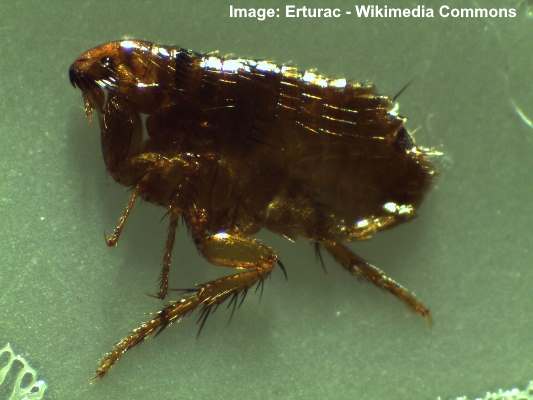
A close up picture of a flea (35x zoom optical microscope)
Fleas are tiny brown biting bugs that measure 0.04” – 0.15” (1 – 4 mm) long. Fleas are so minuscule that the first signs of the annoying bugs are red, itchy bumps on the skin from flea bites. Or you may see signs of fleas if your pets excessively scratch themselves.
Close-up pictures of the tiny brown bugs show they have long legs in relation to their body. The black or brown wingless bugs are challenging to catch because they jump great distances. This makes getting rid of fleas in your house especially tricky. A flea is more than a nuisance bug that causes an itchy rash—they can transmit disease.
House bug Identification: Fleas are identified as tiny black or brown bugs about half the size of a grain of rice. Flea bites look like itchy red dots on the skin and can be hard to distinguish from bed bug bites.
Bed Bugs (Cimex)

The tiny brown bed bugs have a flat body and can quickly infest the house
Bed bugs are tiny brown bugs with oval, flattened bodies and are about the size of an apple seed. The minuscule brown bugs measure 0.16” – 0.2” (4 – 5 mm) long. The nasty bugs bite humans, causing an itchy rash on hands, feet, the neck, or face.
Bed bugs look like fleas or ticks and can quickly infest a home. Because the tiny house bugs can live for two months without feeding and lurk in mattresses, behind baseboards, and in crevices, getting rid of them is challenging.
House bug Identification: Bed bugs are identified as tiny brown creatures with flattened oval bodies and small heads.
Drain Flies (Psychodidae)
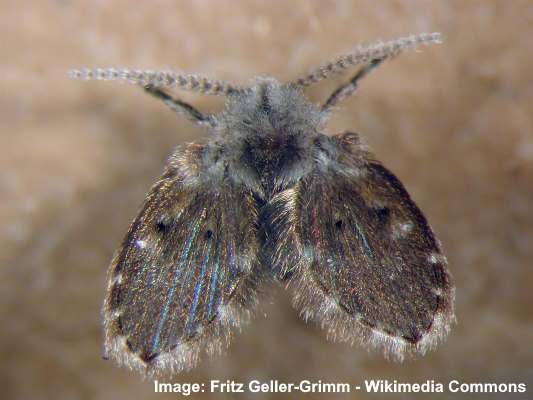
Drain flies are tiny flying house bugs with brown furry look
Drain flies are tiny brown flying house bugs with a fuzzy appearance and grow between 0.06” and 0.2” (1.5 – 5 mm) long. As the name suggests, drain flies are common pests in bathrooms, near sinks, drains, sewers, or basements. The adults lay eggs in standing water, and the tiny flies emerge from drains.
Although they are incredibly annoying, the tiny flying bugs are harmless. To get rid of the flies, it’s vital to remove the breeding site by clearing all organic material from drains. Drain fly larvae look like long flattened cylinders.
House bug Identification: Drain flies are identified as tiny brown furry flies that fly near drains and sinks in kitchens and bathrooms, especially at night.
Fruit Flies (Drosophila melanogaster)

Fruit flies are tiny brown house bugs that especially like sweet rotten fruit
Fruit flies look like tiny brown gnats and hover around fermenting or rotten fruit. Adult fruit flies grow to 0.1” (2.5 mm) long, have a brown body and red eyes. However, the tiny house bugs are so minuscule that you probably won’t see their wings or eyes.
Fruit flies are common wherever food—especially sweet food—is allowed to ferment. The adult flies lay eggs on rotten fruit or other organic material and lay up to 500 eggs in a week. To avoid problems with fruit flies, keep perishable food in the refrigerator, put a lid on the garbage can, and clean drains regularly.
These tiny flies are easy to mistake for fungus gnats. However, fungus gnats usually fly around infested plants, not decaying or rotten fruit.
House bug Identification: Fruit flies are small flying house bugs that are easy to identify because they look like tiny brown flies hovering near trash, rotten food, or empty bottles.
Ticks (Ixodida)

A close up picture of a tick (left) and a tick on human skin (right)
Ticks are parasitic bugs that can become a problem in the house if pets bring them indoors. A tick is about the size of a sunflower seed and usually has a black or brown body. The tiny bugs become engorged if they bury into the skin to feed on blood. Ticks are about 0.2” (5 mm) long but can grow to 0.6” (15 mm) when feeding on blood.
Ticks can carry diseases. So, if you notice a tick buried in your skin, it’s essential to remove it properly and seek medical advice.
House bug Identification: Ticks are identified as tiny tear-shaped bugs with a black or brown body and eight legs.
Related articles:
- Types of Spiders and How to Identify Them
- Types of Beetles – Identification Guide
- Types of Green Insects – Identification Guide
